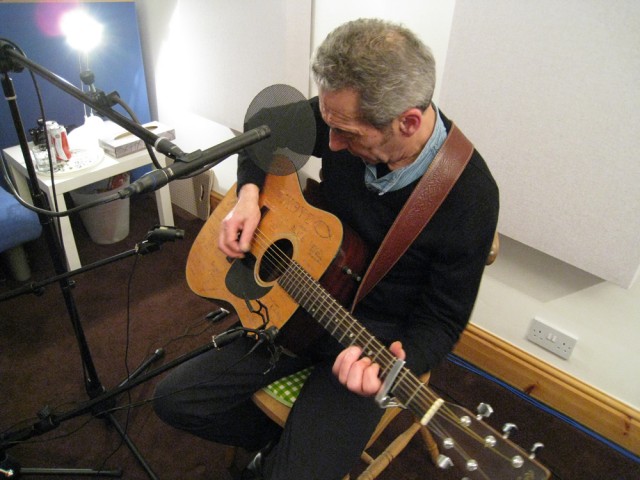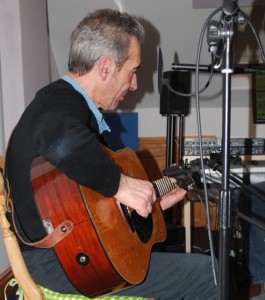Review of the DPA d:dicate 4011 and d:facto 4018V microphones
I had been planning to catch up with blues artist Angelo Palladino for a while and record a few tracks with just acoustic guitar and vocal. Angelo is a very accomplished guitarist so I wanted to really capture the performance aspect of his style in as pure a form as possible.
So I contacted Sound Network, the UK distributors of microphone manufacturer DPA, and asked their advice on microphone choice and setup for this kind of recording session. They suggested a matched pair of DPA d:dicate 4011’s for the acoustic guitar and a d:facto 4018V capsule with MMP-A recording preamp to record Angelo’s vocal.
DPA microphones have a strong reputation for natural sound across a wide range of live and recorded applications, covering choirs, orchestras and with legendary artists such as Sting and Steve Wonder amongst their user list. Add to that a long pedigree in Film/TV and you have possibly one of the most flexible microphone ranges available today.
I was particularly interested in exploring different stereo recording techniques for acoustic guitar and so the session with Angelo was a perfect opportunity to explore three of the more popular stereo miking arrangements. DPA have an excellent guide to these and other stereo miking techniques here on their website.
The d:dicate 4011ER matched stereo pair used in our session are ultra-compact cardioid microphones from the modular DPA d:dicate Recording Microphones series. They have very linear frequency and phase responses and importantly, for my application, very low distortion. With their very compact physical footprint, they are ideal for close-miking instruments like acoustic guitar. Sound Network kindly provided the optional CXO4000 Compact XY/ORTF Stereo Holder which allows the both microphones to be mounted on a single mic stand in either XY or ORTF configurations.
We agreed to start off the session by comparing the ORTF and XY configurations with Angelo playing a short instrumental version of Blackbird. Angelo is playing an early ‘80’s Takamine G330 which has a great sound, which I hoped to capture in all its glory.


First we configured the mics to the XY configuration. This gave us one mic pointing at one end of the sound hole and the other looking down the neck towards the 12th fret, as shown above.
Opinion : The XY configuration provided a well developed sound with good punchy lows, high end perhaps a little bit subdued. This might have actually been a relative increase in bass response due to close proximity of the mics to the guitar rather than a lack of absolute HF. (The DPA 4011 capsules are rated flat response at a distance of 30cm from the source and I think we were miking quite a bit closer than that in XY mode). Stereo width was a bit narrower than ideal but overall an accurate reproduction of Angelo’s style.
Then we reconfigured the mics to the ORTF configuration which sets the mics at an angle of 110° and the mic capsules 17cm apart. This technique was developed by Radio France around 1960, and you can read more about ORTF here.
The DPA 4011s are held in place with a simple rubber ring (fiddly to do but I got the hand of it eventually) so a couple of minutes later we were in ORTF. We pointed one mic to point at the guitar bridge which (with the 110° angle) pointed the second mic just a little past the sound hole.

Opinion : The ORTF configuration gave a well balanced sound with good stereo width, very neutral sounding dynamic. Low end a bit suppressed compared to the XY configuration, very accurate top end reproduction, if anything, a little bit too bright compared to the ‘live’ performance.
After some debate, we agreed that the XY configuration seemed to work best with the G330 and Angelo’s playing style, so we pressed on …
Next we wanted to explore how the 4011’s worked with different degrees of attack on the guitar, so Angelo performed two versions of his original composition ‘Saturday Night’ from his ‘Travelling Dark’ album recorded on Sting’s Pangaea record label in 1994.
This brought into play the second DPA microphone on test, the d:facto 4018V capsule with MMP-A recording preamp. This capsule is designed for close miking vocals and has a slightly narrower supercardioid pattern which provides a higher level of separation from other sound sources. Again the DPA reputation for high definition and very natural response.
Angelo performed the first version of Saturday Night in quite a laid back manner, especially in the guitar style and delivery.

Opinion : We commented on how well the 4011 mics capture the guitar with absolute clarity, while the vocal has plenty of body. You can hear a little of the room ambiance as well. Very nice!
Angelo then suggested he do a much more aggressive version, both in terms of guitar and vocal delivery. We stayed on the XY configuration
Opinion : We were really knocked out by the ability of the DPA mics to cope with the much increased attack and dynamics of this performance. The voice and guitar sit really well together in the mix despite the absence of any EQ or compression polishing. Lots of guitar ‘body’ which we really liked.
I was keen to try the A-B mode of recording. Although we didn’t have a suitable DPA adapter, it was easy enough to rig up a temporary mount converting an SM58 mic mount with some soft foam and soon we had the AB mode set up using a second mic stand as you can see below.

By now Angelo was in a reflective mood so he laid down a very moody version of his song ‘Midnight’ from the 2004 album ‘Blood, Blues & Bad Dreams’.
Opinion : This recording is as near to listening to the original as we’d heard so far. Very accurate vocal with some really nice room acoustics coming through. Angelo’s unique anguished vocal style is well captured by the 4018V and MMP-A combination.
Towards the end of the evening, we asked Angelo what he felt about the DPAs.
‘They don’t let you go. If that’s how you sound – it’s exactly how it sounds [in the recording]. The 4018V really shows your strengths … and your weaknesses! Stunningly accurate … scarily so!.’
‘For acoustic guitar, I’d use the XY more if I was doing the Nick Drake thing. XY was good but the 4011s with A-B is what I’d probably use with the Takamine G330.’
Most folks agree that the choice of microphone and microphone placement has a huge influence on how well vocals and acoustic guitar are recorded. Sure you can do a whole lot of stuff in post production to tidy up a performance but if the original recording isn’t great, then you’re swimming against the tide all the time.
The 4011 stereo pair and 4018V vocal mic are exactly what DPA claim. Accurate, very focused and capable of very high quality recordings. Couple to that a very flexible range of interchangeable mic capsules and mic preamps and you can understand why they have gained such a great reputation across a wide range of live and recorded applications.

Useful Links:
[info] DPA Microphones [/info] [info] Sound Network[/info] [info] Angelo Palladino[/info]Many thanks for Sound Network for supplying the microphones and to Angelo Palladino for some great performances.
Recording Notes
- All original recordings made at 88.2kHz, 24 bit into Sonar.
- The only post recording work was level balancing of the audio sources and bringing all tracks up to the same -1dBFS peak level
- Vocal preamp, Safe Sound Audio Tracking Toolbox
- Guitar preamps, Safe Sound 500 Series P501s
- MOTU converters
- MP3s for streaming converted to 44.1kHz, 16bit at 128Kbps, CBR.
